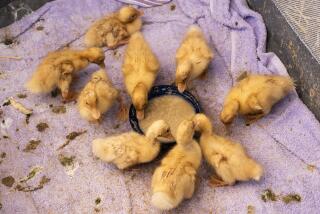Self-Taught Authority : He Takes Sick, Hurt Birds of Prey Under His Wing
- Share via
ESCONDIDO — Randy McCowan says there is no sense growing attached to the birds of prey--the hawks, owls, falcons and eagles-- he cares for because as soon as he releases them they are supposed to fly away and never come back.
But the red-shouldered hawk perched atop the neighbor’s television antenna a while back was the exception to the rule. When McCowan freed it three years ago after nursing it back to health, it took a local mate and hung around McCowan’s rural Harmony Grove neighborhood, perching on antennas, palm trees and telephone poles.
And McCowan, maybe more of a soft touch than he would like people to believe, has made just one exception to his own creed that man should not cater to wild birds of prey.
Sometimes, when he gets home from work, he will grab a piece of beef heart, walk out into his back yard and whistle toward the treetops. After the second or third whistle, the hawk will answer with its own distinctive screech and swoop down from its perch.
McCowan’s timing is perfect. He tosses the hunk of meat into the air. The hawk marks its target, stretches out its wings to brake in midair, grabs the prize with its talons and arches skyward.
McCowan, no stranger to birds of prey, is a self-taught authority on the dozen or so species common to San Diego County. He figures he has cared for 500 of them since he handled his first bird, an injured hawk he found in his backyard five years ago.
Taking care of the bird intrigued him. He contacted the state Department of Fish and Game and eventually was granted a license to care for birds of prey, which are protected and cannot be privately owned. He talked to other authorities on birds of prey and read what relatively few books there are on the subject.
Mostly, he said, he learned by doing--to the point where today state game officials, humane societies and even the San Diego Wild Animal Park refer to McCowan people who have questions about birds of prey, or who have found an injured or infant raptor in their own yard.
McCowan established the North County Rehabilitation Center--his backyard operation--and its reputation as an orphanage and hospital for birds of prey has spread throughout much of the state. He has received calls--and injured birds--from as far away as Yosemite and from throughout San Diego County.
Helpless Fledglings
Most of McCowan’s work is with baby birds too young to fly, brought to him after they fell--or were taken--from their nests and were unable to care for themselves. McCowan keeps as many as 30 of them in small, portable wooden cages stacked inside his garage. He feeds them daily, going through 300 pounds of beef hearts, plus vitamins and egg yolks, during the three-month “baby season” every spring before the birds are mature and ready to fly away on their own.
In his backyard are half a dozen larger enclosures occupied by mature birds on the mend from a variety of injuries, or by birds permanently injured and unable to fend for themselves in the wild. They are kept by McCowan for use in talks he gives to schools and interested groups. The birds can also be viewed from 1 to 4 p.m. on Saturdays and Sundays, when McCowan invites the public to visit his bird center on Cordrey Drive.
Among the birds cared for by McCowan are some that have been shot--intentionally or not--by hunters, hit by automobiles, caught in barbed-wire fences or weakened by days of stormy weather. If a wing is broken, McCowan will tape it. If the bird is weak, he will simply give it food and time to regain strength. If there are internal injuries, McCowan will seek out a veterinarian familiar with birds of prey.
Some birds are turned over to McCowan by people who have kept them illegally as domestic pets since birth and, for whatever reason, are ready to set them free--even though the bird may be woefully inadequate as a hunter in the wild.
McCowan, who spends his time with the birds after he gets home from his job as a telephone company installer, says his project costs about $2,000 a year, mostly for food. To help defray the expense, he has published and sells for $10 a 28-page catalogue of color photographs--with accompanying descriptions--of the 11 most common birds of prey found in Southern California.
More to Read
Sign up for Essential California
The most important California stories and recommendations in your inbox every morning.
You may occasionally receive promotional content from the Los Angeles Times.













